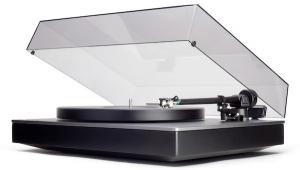geometry dash breeze is an exhilarating addition to the beloved Geometry Dash series, offering players a vibrant and rhythmic platforming experience.
SME Model 30/2 turntable Page 4
Lyra's Helikon and Titan cartridges sound extremely neutral to me, though those who like the lusher sound of some Benzes and Dynavectors find them drab and colorless. But instead of sounding even more colorless through the less colored SME, the Helikon and Titan actually sounded richer, more fleshed-out and coherent, than I was used to hearing them through the Simon Yorke. How can that be? I figure the Lyras' extended high-frequency energy (compared with the more muted-sounding cartridges) excited resonances in the Yorke but not in the SME, hence the latter's smoother sound.
One night I went through almost the entire The Complete Studio Recordings of the Miles Davis Quintet: 1965-1968 (Mosaic MQ10-177, 10 LPs), marveling at the precise image of Miles standing before the microphone, and the wealth of musical and thought detail I'd simply never heard before. I pulled out what I'd thought was an undistinguished-sounding disc, an original RCA Ziggy Stardust (UK, SF 8287), and found that it was amazingly distinguished. And I discovered that when mastering engineers play serious games with EQ, the "ledges" stick out obtrusively, as on too many original Mobile Fidelity Sound Lab LPs.
The problem with telling such hyperventilating stories only a few months after my July 2002 review of the Boulder 2008 is that it sounds like the same old song. The fact is, the SME 30/2, like the Boulder, actually is that good—and better. It allowed every record I threw at it to sound more detailed, yet less edgy and artificial. Its sense of rhythmic certainty and its ability to unravel and clarify complex musical passages never failed to amaze. Was it better than the Rockport? In the bass, yes. I'm confident of that, despite the changes in my system since that review. Otherwise, I'd say the SME and the Rockport are at least on a level playing field, with tradeoffs on both sides.
I found no negatives. While I'd found the SME 10 to sound somewhat dry, with perhaps a "skeletal" harmonic quality from the midbass to the upper midrange, the Model 30/2 exhibited no such coloration. The SME 30/2 is perhaps the most tonally neutral turntable I've ever heard. Only the Rockport System III Sirius, which includes an integral tonearm, is in the same league, and it doesn't stand up to the SME's low-frequency extension and solidity.
Choice of Arms?
My review sample of the SME Model 30/2 came with the SME IV.Vi tonearm, which I covered in the SME 10 review in the April 2000 issue, so I won't repeat myself here. But I did get hold of a Graham armboard so I could try two arms. Rick Rosen was visiting when I decided to make the switch. We listened to the SME IV.Vi for a while, then auditioned the Graham 2.2. One of the records we played was a test pressing of the vinyl edition of Alison Krauss's Forget About It (Diverse DIV 002LP), cut from a DSD master. We compared that to the SACD (Rounder 11661-0465-6) on the recently arrived combo of dCS's Elgar Plus DAC, Purcell upsampler, and Verdi SACD transport (currently under review).
Interestingly, the Graham 2.2 (with Lyra Titan cartridge) more closely resembled the SACD than did the SME IV.Vi. Both the SACD and the vinyl through the pairing of Graham 2.2 and SME 30/2 revealed a pleasant, warm cushion behind Krauss's voice. The SME IV.Vi dried that out a bit, giving the overall sound the precise "skeletal" harmonic quality, from midbass to upper midrange, that I'd complained of in the SME 10 review.
In any case, while both arms sounded great on the SME 30/2, Rick and I agreed that, if we were buying an SME 30/2 for my system, we'd go for the Graham 2.2. Detractors of unipivot arms would say that the Graham's inability to control bass energy was adding the warmth we heard and preferred, but we heard it on the SACD too. That was good enough for us.
Conclusions
A tour of the SME factory a few years ago and a visit with designer Alastair Robertson-Aikman convinced me that few, if any, companies in high-end audio can match SME's machining prowess. The company does precision CNC machining and measuring for the medical industry, for Formula One racing, for aerospace and aviation, and, fortunately for audiophiles, for the audio industry.
The SME Model 30/2's precision-machined parts (including an ultra-quiet, ultra-smooth-running main bearing), its superb damping and isolation, its high-mass, low-flex plinth, its accurate, stable drive system, and, most of all, its sound or lack thereof, might just make it the finest turntable in the world. It's certainly one of the two best I've (n)ever heard, and the other one costs more than twice as much (but includes an integral arm).
I ended my review of SME's Model 10 with "Can SME's $22,000 Model 30 really be that much better?" The answer is "Yes!" Overall, the SME Model 30/2 is the best turntable I've heard.
- Log in or register to post comments





















































